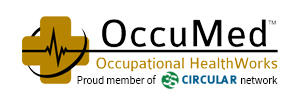As the coronavirus continues to spread, not only abroad but also here in the United States, and treatment has not yet been identified, the CDC recommends the following steps to remain vigilant.
Employees who are well but who have a sick family member at home with COVID-19 should notify their supervisor and refer to CDC guidance for how to conduct a risk assessment of their potential exposure.
The public health guidelines from the CDC’s risk assessment guidelines for workplaces recommend that people with low-risk exposures to SARS-CoV-2 do not need to be restricted from public places, including workplaces, as long as they remain asymptomatic.
Asymptomatic people with low-risk exposures are advised to self-observe until 14 days after their last potential exposure. Employers may choose to recommend that employees with low-risk exposures check their temperature to ensure they are still asymptomatic before arriving at the workplace.
People with confirmed COVID-19 should remain in isolation, either at home or in a healthcare facility as determined by clinical status, until they are determined by state or local public health authorities in coordination with CDC to be no longer infectious.
The location of isolation will be determined by public health authorities and isolation may be compelled by public health order, if necessary.
Asymptomatic people with medium-risk exposures are recommended to avoid congregate settings, limit public activities, and practice social distancing.
Employers may consider on a case-by-case basis, after consultation with state or local public health authorities, whether asymptomatic employees with medium-risk exposures may be able to work onsite. These decisions should take into account whether individual employees’ work responsibilities and locations allow them to remain separate from others during the entire workday.
Asymptomatic employees with medium-risk exposures who are permitted to work onsite should not enter crowded workplace locations such as meeting spaces or cafeterias.
If an employee is confirmed to have COVID-19 infection, employers should inform fellow employees of their possible exposure to COVID-19 in the workplace but maintain confidentiality as required by the Americans with Disabilities Act (ADA). Employees exposed to a co-worker with confirmed COVID-19 should refer to CDC guidance for how to conduct a risk assessment of their potential exposure.
If you have concerns about your workforce and coronavirus, please contact us today to learn about steps you can take to protect yourself, your family, and your employees.
Now that COVID-19 has reached the U.S., employers need to plan to be able to respond in a flexible way to varying levels of severity and be prepared to refine their business response plans as needed.
For the general American public, such as workers in non-healthcare settings and where it is unlikely that work tasks create an increased risk of exposures to COVID-19, the immediate health risk from COVID-19 is considered low.
The CDC and its partners continue to monitor national and international data on the severity of illness caused by COVID-19 and will disseminate the results of these ongoing surveillance assessments, while making additional recommendations as needed.
Planning Considerations
All employers need to consider how best to decrease the spread of acute respiratory illness and lower the impact of COVID-19 in their workplace. They should identify and communicate their objectives, which may include one or more of the following:
(a) reducing transmission among staff,
(b) protecting people who are at higher risk for adverse health complications,
(c) maintaining business operations, and
(d) minimizing adverse effects on other entities in their supply chains.
Some of the key considerations when making decisions on appropriate responses are:
1. Disease severity (i.e., number of people who are sick, hospitalization and death rates) in the community where the business is located;
2. Impact of disease on employees that are vulnerable and may be at higher risk for COVID-19 adverse health complications. Inform employees that some people may be at higher risk for severe illness, such as older adults and those with chronic medical conditions.
3. Prepare for possible increased numbers of employee absences due to illness in employees and their family members, dismissals of early childhood programs and K-12 schools due to high levels of absenteeism or illness:
- Employers should plan to monitor and respond to absenteeism at the workplace. Implement plans to continue your essential business functions in case you experience higher than usual absenteeism.
- Cross-train personnel to perform essential functions so that the workplace is able to operate even if key staff members are absent.
- Assess your essential functions and the reliance that others and the community have on your services or products.
- Be prepared to change your business practices if needed to maintain critical operations (e.g., identify alternative suppliers, prioritize customers, or temporarily suspend some of your operations if needed).
4. Employers with more than one business location are encouraged to provide local managers with the authority to take appropriate actions outlined in their business infectious disease outbreak response plan based on the condition in each locality.
5. Coordination with state external and local external health officials is strongly encouraged for all businesses so that timely and accurate information can guide appropriate responses in each location where their operations reside.
Since the intensity of an outbreak may differ according to geographic location, local health officials will be issuing guidance specific to their communities.
If you have concerns about your workforce and coronavirus, please contact us today to learn about steps you can take to protect yourself, your family, and your employees.
If you have concerns about your workforce and coronavirus, please contact us today to learn about steps you can take to protect yourself, your family, and your employees.
All employers should be ready to implement strategies to protect their workforce from COVID-19 while ensuring continuity of operations.
During a COVID-19 outbreak, all sick employees should stay home and away from the workplace, respiratory etiquette and hand hygiene should be encouraged, and routine cleaning of commonly touched surfaces should be performed regularly.
Employers should:
- Ensure your Infectious Disease Outbreak Response plan is flexible and involve your employees in developing and reviewing your plan.
- Conduct a focused discussion or exercise using your plan, to find out ahead of time whether the plan has gaps or problems that need to be corrected.
- Share your plan with employees and explain what human resources policies, workplace and leave flexibilities, and pay and benefits will be available to them.
- Share best practices with other businesses in your communities (especially those in your supply chain), chambers of commerce, and associations to improve community response efforts.
Recommendations for an Infectious Disease Outbreak Response Plan
Identify possible work-related exposure and health risks to your employees. OSHA has more information on how to protect workers from potential exposures external to COVID-19 at https://www.osha.gov/SLTC/covid-19/.
Review human resources policies to make sure that policies and practices are consistent with public health recommendations and are consistent with existing state and federal workplace laws (for more information on employer responsibilities, visit the Department of Labor’s and the Equal Employment Opportunity Commission’s websites).
Explore whether you can establish policies and practices, such as flexible worksites (e.g., telecommuting) and flexible work hours (e.g., staggered shifts), to increase the physical distance among employees and between employees and others if state and local health authorities recommend the use of social distancing strategies. For employees who are able to telework, supervisors should encourage employees to telework instead of coming into the workplace until symptoms are completely resolved. Ensure that you have the information technology and infrastructure needed to support multiple employees who may be able to work from home.
Identify essential business functions, essential jobs or roles, and critical elements within your supply chains (e.g., raw materials, suppliers, subcontractor services/products, and logistics) required to maintain business operations. Plan for how your business will operate if there is increasing absenteeism or these supply chains are interrupted.
Set up authorities, triggers, and procedures for activating and terminating the company’s infectious disease outbreak response plan, altering business operations (e.g., possibly changing or closing operations in affected areas), and transferring business knowledge to key employees. Work closely with your local health officials to identify these triggers.
Plan to minimize exposure between employees and also between employees and the public, if public health officials call for social distancing.
Establish a process to communicate information to employees and business partners on your infectious disease outbreak response plans and latest COVID-19 information. Anticipate employee fear, anxiety, rumors, and misinformation, and plan communications accordingly.
In some communities, early childhood programs and K-12 schools may be dismissed, particularly if COVID-19 worsens. Determine how you will operate if absenteeism spikes from increases in sick employees, those who stay home to care for sick family members, and those who must stay home to watch their children if dismissed from school. Businesses and other employers should prepare to institute flexible workplace and leave policies for these employees. Local conditions will influence the decisions that public health officials make regarding community-level strategies; employers should take the time now to learn about plans in place in each community where they have a business.
Now that the COVID-19 outbreak has reached the US, consider canceling non-essential business travel to additional countries per travel guidance on the CDC website. Travel restrictions may be enacted by other countries which may limit the ability of employees to return home if they become sick while on travel status.
Consider cancelling large work-related meetings or events.
Engage state external and local external health departments to confirm channels of communication and methods for dissemination of local outbreak information.
If you have concerns about your workforce and coronavirus, please contact us today to learn about steps you can take to protect yourself, your family, and your employees.
If you have concerns about your workforce and coronavirus, please contact us today to learn about steps you can take to protect yourself, your family, and your employees.
Download Further Information:
Coronavirus Fact Sheet
Coronavirus Symptoms
Help Stop the Spread
Public Health Management Decision-Making


